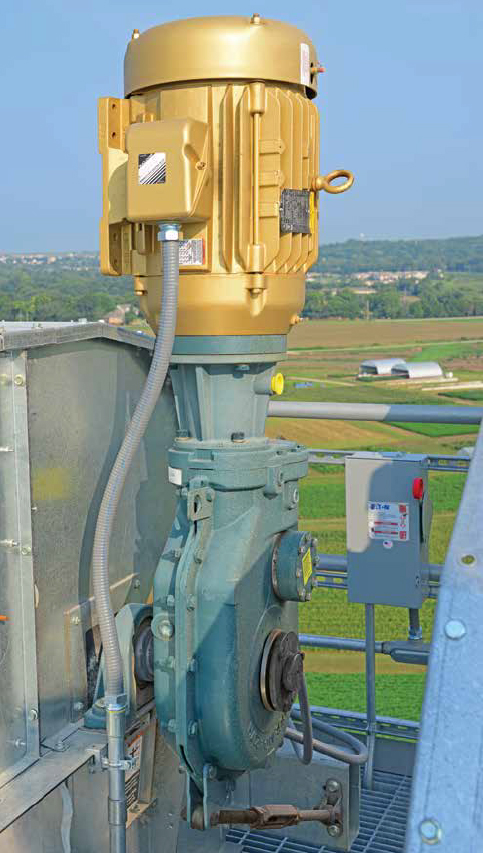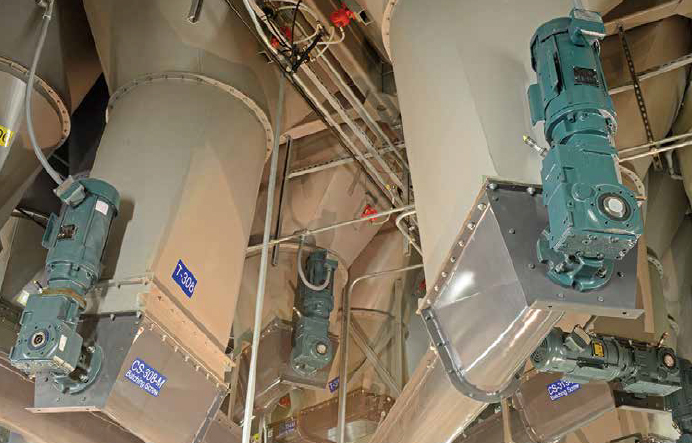
Detail
Top Industry OEMs Choose Baldor Products to Equip World-Class Feed Mill
The O.H. Kruse Feed Technology Innovation Center, the new home of the Kansas State University Feed Science and Management program, includes a modern, automated 5-ton-per-hour production and teaching feed mill and a biosafety level 2 teaching and research feed mill. This 142-foot-tall, state-of-the-art facility opened in October 2013.
A lead gift of $2 million to fund the project came from the Kruse family to honor company founder O.H. Kruse, and stress the importance of educating and preparing the next generation of feed industry professionals. The state and the university provided additional funding, but the project also received tremendous support from grain industry OEMs, who contributed nearly $3 million worth of in-kind equipment donations. Dirk Maier, head of K-State’s Department of Grain Science and Industry, says the department has always framed the project as a partnership between industry and the university.
“When you have a program like ours that is so closely tied to the industry, it’s critical for us to have the right facilities to educate and train our students, and familiarize them with the actual processes and equipment they will work with after graduation,” says Maier. “Of course, our other mission is training industry professionals, so to have a facility where we can do both is obviously hugely important to us.”
Determining who to ask, and what to ask for, was left to Fred Fairchild, K-State professor emeritus. Fairchild was uniquely qualified for the task, because not only is he a K-State grad, he also worked for 30 years in the grain industry as a licensed professional engineer, designing and constructing grain processing projects, before returning to the university to teach in the Department of Grain Science. As equipment suppliers signed on to help with the project, Fairchild shared his desire that Baldor’s Dodge® gearing be used on the equipment where possible. He says he based that request on his experience, both in the classroom and in the field.

ASI-Industrial, the subcontractor responsible for building the slip-formed concrete main tower, as well as approving and installing all the equipment in the facility, agreed with Fairchild’s assessment. Johny Starnes, ASI-Industrial application engineer, says his company, which specializes in the design, development and construction of bulk material processing plants, almost exclusively specifies Baldor products on its projects. And he says he wasn’t surprised that other OEMs participating in the project were also choosing Baldor. In fact, the only change he suggested after reviewing submitted drawings was to switch to a different style of Baldor•Dodge® gearing.
“We wanted companies to use the new right-angle beltless reducer called the Motorized Torque-Arm II,” explains Starnes. “Not only is the MTA very easy to install, it’s also safer, because we get rid of all the belts and guards. And with no belts to deal with, it’s one less thing to check off the maintenance list.” Starnes also recommended a switch to Baldor’s Dodge Quantis® RHB (right-angle helical bevel) reducers in a few other applications, recommendations that Fairchild supported.
“I liked that both the MTA and Quantis reducers are self-sealed and require less maintenance,” says Fairchild. “These are state-of-the-art products, and since this is an innovation center, we wanted the latest technology.”
Industry Support
Screw Conveyor Corporation was happy to accommodate the changes on the screw conveyors and the screw feeders it supplied for the project. Anita Kozlowski, the company’s national sales manager, says meeting Fairchild’s requirement for a Baldor•Dodge specification was easy, because all of Baldor’s products are part of the company’s standard offering. Kozlowski says her company has worked with other universities in the past, but says this was a very special project, and her company wanted to do its part to make it a success.
“Professor Fairchild invited us to visit the campus and meet the students,” explains Kozlowski. “We were very impressed with K-State and their department of grain science, and we were amazed at the innovative way they were thinking about the future. We were also impressed with Professor Fairchild; his years of experience in the industry and his commitment to the university made it very easy for us to say yes to his request to participate.”

“Intersystems has a long history of supporting projects that support the feed industry,” says King. “Of course, as alumni, both Craig Jones and I wanted our company to help with the project. But it really wasn’t a tough sell to our leadership, because it fit right in with Intersystems’ commitment to serving the industry that supports us.”
In addition to the processing operation, the feed mill also contains corrugated grain bins that will allow large-scale grain storage and grain quality preservation research. The 20,000-bushel-capacity bin was donated by SCAFCO. Randy Peterson is the material handling manager for SCAFCO grain systems, and designed the material handling portion of the conveyors and elevators using MTAs with Baldor Super-E premium efficient motors. He describes Baldor’s offering as “quality American products” and especially liked the looks of the MTA for this project because its smaller profile helped save space. And while this is the first time his company has worked on a project for a university, it was a great way to begin.
“This was a unique opportunity for us to be involved in a project where our equipment would be a part of a research facility,” says Peterson. “This feed mill will attract and train industry people from all over the world. It was clear to us that the university has a very well-thought-out strategy to support students, as well as the industry, and we are happy to be a part of it.”
It’s difficult for university officials to put into words just how grateful they are to all of the OEMs that contributed, and they hope this kind of generosity is rewarded with opportunities for new business. But Charles Stark, K-State feed technology associate professor, believes these companies, and the industry as a whole, will all benefit because of the quality students the program will graduate.
“This feed mill gives us the opportunity to offer hands-on training in an environment where the students are working on the latest technology,” says Stark. “KSU students will graduate and walk into a commercial facility and will recognize the processes and equipment. Their new employer won’t have to teach them about what a new, modern facility looks like, because they worked in one here at KSU.


